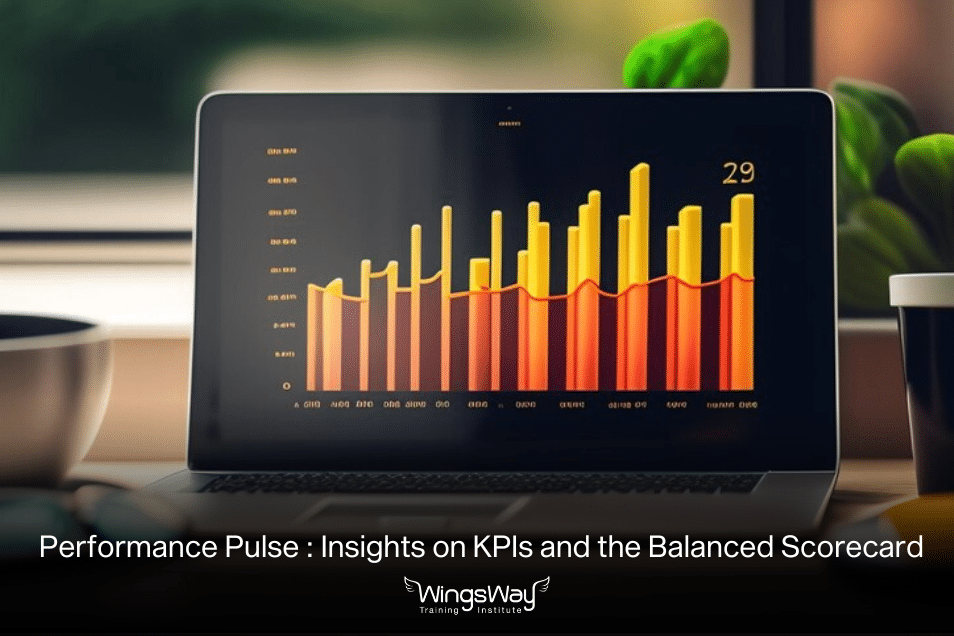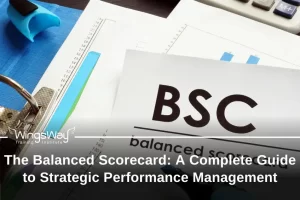
Performance Pulse: Insights on KPIs and the Balanced Scorecard
Organizations strive to seek better performance and competitive advantage in the modern dynamism of the business environment. The statistic that only 2% of CHROs believe their performance management system is effective underscores the need for a significant overhaul in how performance is managed in organizations. In light of this, Wingsay Training Institute, one of the leading institutes in Dubai, delves into the power of Key Performance Indicators (KPIs) and the Balanced Scorecard framework to drive strategic alignment and performance enhancement in organizations.
KPIs are the specific, measurable values which allow an organization to track ongoing progress and assess the achievement of specific targets set by them.
The Balanced Scorecard is a strategic management framework that translates an organization’s vision and strategy into a set of performance objectives and measures.
Key Performance Indicator
Importance of KPI
KPIs provide precise information on a range of topics, including employee happiness, performance enhancement, and knowledge retention, which aids in measuring the effectiveness of corporate training initiatives. A survey by Deloitte found that 72% of organizations use HR KPIs to track and manage employee performance.
According to the Society for Human Resource Management (SHRM), 68% of HR departments regularly use KPIs for various HR functions.
A good key performance indicator should do all these things:
- Show and track your company’s most crucial outputs.
- Act as the core of your performance management system and show if you’re making progress on your strategy.
- Gauge the measurable parts of your goals and objectives.
- Keep an eye on the most important leading and lagging measures in your company.
Elements of KPI
KPIs show if you’re making headway or how close you are to hitting your targets. In the end, you want to advance your strategy. Good strategies keep tabs on how key parts of the plan are doing. Every key performance indicator needs to have these things:
- A Measure: Every KPI needs a measure. The best ones have clear and detailed measures.
- A Target: Every KPI should have a target that fits your measure and goal timeline. These are numbers you want to reach.
- A Data Source: Each KPI must have a well-defined data source. This helps avoid confusion when measuring and tracking each one.
- Reporting Frequency: Different measures might need different reporting schedules. A good rule is to report on them at least once a month.
- Owner: This isn’t something you have to include in your KPI statement, but it’s pretty useful to figure out who’s gonna keep an eye on, report about, and tweak specific KPIs. It helps your overall plan for the organization run smoother.
Benefits of an effective KPI
When you put KPIs into action the right way, they have a big impact on how well a company does, both day-to-day and in the long run. Corporate training uses KPIs to systematically measure, evaluate, and improve the effectiveness and impact of training programs. Here are some of the benefits of KPI:
- Data-Driven Decision Making
- Enhanced Accountability
- Focus on Key Areas
Examples of some of the effective KPIs include Number of contracts signed per quarter, dollar value for new contracts signed per period, number of qualified leads per month, number of engaged qualified leads in the sales funnel, hours of resources spent on sales follow up and many more.
Balanced Scorecard:
Importance of Balanced Scorecard
The balanced scorecard helps owners to turn the company’s big goals into things they can measure. It’s a way to keep track of how well the company is doing and make changes if necessary. This system makes sure the company stays on track to reach its target.
According to the Balanced Scorecard Institute, around 45% of HR departments in large organizations use BSC to align HR activities with organizational strategy. HR departments using BSC report a 20% improvement in alignment between HR activities and business strategy, according to a study by Harvard Business Review.
Here are the main reasons why it’s important:
1. BSC helps companies and various corporate training programs to make a clear plan by drawing out their business idea on a Strategy Map. This lets owners and everyone else see which goals have a big impact and which ones don’t do much. This way, they can focus more on plans that make good things happen.
2. It gives a simple picture of what the company wants to do. This makes sure everyone gets what the plan is. It stops people from getting the wrong idea and helps everyone understand their job in making the plan work.
3.BSC makes sure everyone’s on the same page by mapping out goals. This helps to line up the whole organization and gets everyone to take part in the strategy. It’s a way to keep all the important people working towards the same things.
Perspectives of Balanced Scorecard
The balanced scorecard approach looks at performance from four angles.
- Financial analysis, which has measures like operating income, profitability and return on investment
- Customer analysis, which checks out money spent on customer service and keeping customers.
- Internal analysis, which sees how internal business processes connect to big-picture goals.
- The learning and growth angle checks how happy and loyal employees are and also looks at information resources.
Examples of the organizations that effectively use balanced scorecards include General Electric (GE),Ritz-Carlton Hotel Company,UPS (United Parcel Service) and many more.
Difference between KPI and BSC
- Scope: The BSC gives a wider and more balanced picture of how an organization is doing across different areas, while KPIs are more focused and measure specific results or things achieved.
- Strategic vs. Operational: The BSC is about big-picture planning lining up with long-term goals and showing the way for the whole organization, while KPIs are more about day-to-day work looking at and managing how things are going at the ground level.
- Measurement Approach: The BSC looks at both what might happen and what has happened across different areas to make sure they’re checking performance , while KPIs look at what’s already happened or what’s happening now in specific areas.
The Wingsway Training Institute course on KPIs and Balanced Scorecard
WingsWay Training Institute is known for its comprehensive corporate training programs, including those focused on KPIs and Balanced Scorecards. Those who will be pursuing this course will become an expert at setting insightful KPIs that relate to the objectives of your company, monitoring results, pinpointing areas in need of development, and making defensible decisions based on facts. The coursework topics include:
- Introduction to KPIs and Balanced Scorecard
- Using KPIs and Balanced Scorecard for Decision-Making
- Developing Effective KPIs
- Designing a Balanced Scorecard



